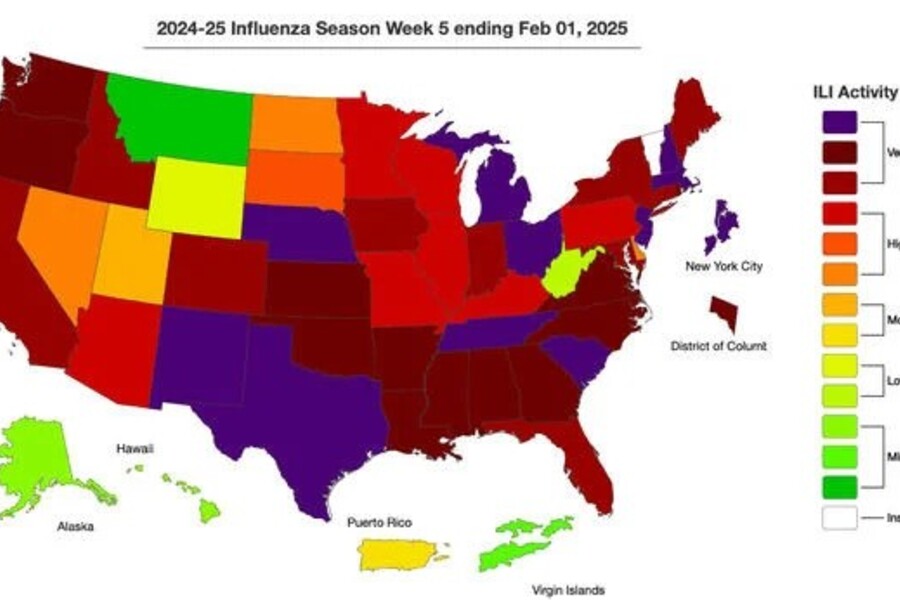The U.S. is grappling with a surge in influenza cases that have reached their highest point since the 2009 H1N1 swine flu pandemic, according to new data released by the Centers for Disease Control and Prevention (CDC) on Friday. This unexpected second wave of flu infections is fueling concerns as respiratory illnesses hit “very high” levels across much of the country.
The CDC reports that 8% of outpatient visits nationwide last week were flu-related—a staggering increase. Health experts note this is the highest level recorded in the CDC’s influenza surveillance network since the peak of the swine flu outbreak over a decade ago. While seasonal flu cases tend to spike after the holidays, this year’s resurgence has reached extraordinary levels, surpassing recent years’ peaks.
The wave of flu infections has compounded an already strained healthcare system, coming as the nation continues to face a smaller but persistent wave of COVID-19 cases. Testing data shows a concerning trend: more than 31.6% of flu tests last week were positive, nearly double the peak rate of 18.2% seen last flu season.
The CDC’s current analysis indicates that flu activity is still on the rise in 15 states, while other states may have either reached their peak or seen a decline in cases. However, the situation remains serious in certain areas, including Kentucky, where pediatric hospitals have reported alarming numbers of flu cases.
Dr. Kris Bryant, a pediatric infectious disease specialist at Norton Children’s Hospital in Louisville, described the situation as “extraordinarily high” in her region. Last week alone, her hospital recorded over 3,000 positive flu cases in children. She expressed concern about the severity of some flu complications, including seizures and rare instances of brain inflammation.
“Some parents don’t realize how dangerous the flu can be beyond its respiratory symptoms,” Dr. Bryant warned. “Pediatricians across the country are seeing severe cases that are deeply concerning.”
Compounding the issue is a drop in flu vaccination rates, particularly among children. The CDC reports that this year’s vaccination rate for children is at its lowest point in six years. Overall, fewer than half of all Americans have been vaccinated for the flu this season. Dr. Bryant attributes part of the decline to ongoing vaccine hesitancy in the wake of the COVID-19 pandemic.
Unlike the 2009 swine flu outbreak, the current spike in flu cases is driven by familiar seasonal virus strains rather than a novel pathogen. Still, the country has seen other flu-related challenges this year. Farms across the U.S. have been hit by a record outbreak of H5N1 bird flu, causing supply disruptions and driving up egg prices nationwide. Fortunately, human cases of bird flu remain rare, with no evidence of widespread human-to-human transmission.
Despite these challenges, public health officials stress that the current flu situation demands swift action. Hospitals across the country, particularly pediatric units, are bracing for continued strain on healthcare resources in the coming weeks.
The CDC is urging Americans to take preventive measures, including getting vaccinated, washing hands frequently, and staying home when sick to help curb the spread of the virus. Dr. Bryant emphasized the importance of community-wide efforts to reduce infections and prevent severe outcomes.
“We need people to understand that flu isn’t just a common cold,” she said. “Without proper precautions, we risk overwhelming our hospitals and endangering vulnerable populations.”
The spike in flu cases has prompted renewed calls for public health vigilance. Officials are closely monitoring infection rates and encouraging citizens to remain alert as the country faces what could be a critical few weeks in the battle against this year’s flu season.
Experts agree that timely intervention and increased vaccination efforts could help prevent further escalation. For now, the message is clear: take action to protect yourself and your community as the nation grapples with the most severe flu outbreak in over a decade.
